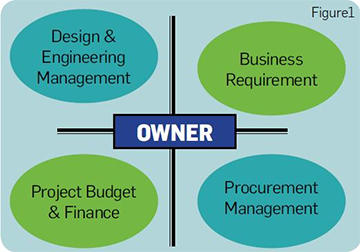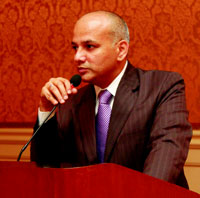Balanced Project Management
The Old Adage That Right Team In Wrong Hands Or Wrong Team In Right Hands Both Hold Good And This Is What Makes Choosing The Right Project Team Tricky.
Continuing our series on Balanced Project Management (BPM) wherein we covered what is BPM and the importance of Project Mandate, a vision document prepared by the project Owner setting out the main expectations from the project team. We also touched upon the importance of the project team, akin to horses for races.
In this edition we cover what I consider to be the next Big Stone in Good Project Management Practices (gPMP) i.e., choosing the project Team which is vital to the delivery of the project, many a time, determining the success or failure of the project on its own.
Project Team
Team for understanding & translating business requirement
As shown in the Figure1 indicating various aspects of project initiation, most projects get initiated due to end user requirement or what is called business requirement, be it a property developer who builds for renting, leasing or selling or anentity that develops space to meet its growth plans.
It is in this stage of the project that a team having a good grasp of the business that the developer or entity is in is required. Typical mistakes due to choice of wrong team members or members without adequate reach in the management hierarchy are improper / inadequate transfer of Owner's requirements to the Architect / Consultants, lack of foresight in planning for future growth, lack of knowledge transfer from internal stakeholders of Owner leading to the facility not serving its intended purpose. Quite often, this slip-up is discovered too late in the day leading to costly rectification / amendments to the design or construction.
The above phenomena would also lead to cost & time overruns not to mention affecting quality due to wrong sequencing. We have also seen plans being totally aborted since the end-user group just could not accept the space delivered since the Owner's project team did not provide what was needed. Some businesses require specialized facilities like cold rooms, clean rooms, data centers, hub rooms, air locks and other requiring specialized knowledge and intricate cross functional co-ordination all of which can throw the project out of gear. Many of these facilities to be built also require compliances to authority requirements like NBC, GBC, EHS etc which need to be planned from day one and a team having a good grasp of these matters would greatly help.
 |
Under these circumstances a strong in-house team of the Developer / Owner having a complete understanding of the business and requirements of the planned facility would be priceless. It is also common to find different groups within the Owner / Developer indulging in turf war and one-upmanship resorting to working in silos with very little understanding of the consequences of their actions. It is here that the Developer / Owner team need to have a strong team leader or driver who is desirably placed above all the team members in order to ensure project mandate is met. A strong team leader having full management support is better than having no leader or having a weak leader who cannot control the team. Another equally disturbing trait to avoid is that of the leader or any team member claiming to be a know-all and misleading the team. It is important that the Owner understands and accepts the limitations that he or his team possess and accordingly allows the professionals to guide and consult.
Team of Architect, Consultants and Project Managers
One of the most important and often overlooked decisions in a construction project is the selection of the architect, who as the creator is responsible for not only the form and environment, but also for the maintainability, aesthetics, quality and longevity of the built construction. Closely followed by the choice of Architect, comes the choice of consultants structural, electro-mechanical services, energy efficiency, lighting, networking, audio-visual, acoustics, landscaping and so on. Each of them bring their own specialisation and expertise into a project and a wrong choice of any one of them would greatly impact not only the budget and functionality of the building but also utility value, lifecycle cost and so on. Next in the order of priority is the choice of a good project manager or a project management consultant which is really a Make or Do decision that is taken by the project Owner. When choosing a project manager in a Make situation (where the project is handled by in-house team), the key parameters to look for are the relevant experience of the person, proven track record in managing similar projects & team, reference of industry professionals and not the least being the ability of the project manager to have a balanced view of the project as a whole rather than just the architectural, structural or services part of the building or only having inclination towards site operations or commercial aspects of project. While making the Do decision (where the project management for the project is delegated to an outside agency), some of the key points to look for are the commitment of the top management of the agency for success of the project, whether they have experience in handling similar projects, referrals from industry professionals / other project Owners, proven track record of completing projects to the requirement to name a few that have a bearing on the project success.
In India, increasingly Owners and especially corporate houses, perhaps influenced by best practices in project management from the IT industry, are resorting to use of elaborate metrics to choose the project team based on technical qualification, team strength, current commitments & scalability, experience in similar projects and other parameters which is a welcome sign in the right direction. The technical & commercial aspects of pre-qualifications are separated and only those who clear the technical qualifications are considered for the commercial round. This will reduce impulsive or impressionable decisions and spreads the decision making risk over a larger mixed group.
Whichever option one chooses as project Owner, negotiating and documenting the key deliverables and expectations from the team and setting out clear markers for measurement of performance is key to ensuring the risks related to project team are mitigated. Having set out the above it is important that a periodic review, usually once a week during the design development & procurement stages of the project are religiously conducted with everyone in attendance. The project Owner or the Project Manager, as a representative of the Owner drives these meetings and performance of each team member against committed deliverables is reviewed and follow up action initiated. Once most of the issues related to design & procurement are closed, these review meetings can be spaced out on a need-to basis.
Design & Engineering Management
By far the single most important (and most often neglected) phase of the project is the design management where the brief is passed on to the architect / consultants and the designs get developed into specifications, drawings and tender documents. It is the duty of the Owner to provide the project brief or mandate to the selected team (be it in-house or external) in written document form even though the team has worked together on several projects earlier. It is at this stage the project co-ordinator starts taking charge and drives the deliverables of each of the team members and ensures that there is adequate cross functional co-ordination and closing of loop in decision making which are normally the weak links in any project.
The project Owner must clearly set the expectations on what constitutes closure of concept design, preliminary design, pre-final design and final good for tender design and insist on Design Basis Reports (DBRs) prepared by the architect and respective consultants setting out the basis of their design philosophy, understanding of Owner's requirements, codal provisions, materials & workmanship proposed, top line budgetary costing and any bench-marking adopted while designing the facility. Some major pitfalls at this stage attributable to Owner are lack of clear understanding of design process, inability to review all aspects of project, failure to compare DBR output with input of project mandate, delayed or non-appointment of other specialist consultants who may be required like Process, LEED, Landscape, Lighting etc., that will have impact and others. Team of Architect / Consultants may also fail at this stage for following reasons - failure to do a thorough review of the DBRs of other stakeholders of the project so as to note the impact on their own scope, cross functional co-ordination, lack of understanding of Owner's brief, inadequate review by seniors leading to DBR being very generic rather than project specific missing out some key elements among others. Biggest casualties at this stage is the project timelines the need to close the loop and ensuring specifics of the project are addressed by all, lack of periodic review & follow ups lead to avoidable delays in the duration allocated for Design Development phase of the project thereby pushing the project end date.
Some Owners resort to cutting down on durations for other downstream activities like procurement, construction of structure or finishes, sometimes to unreasonable levels, which I personally feel is counterproductive to the project mandate and hence should be avoided. Simple rule at every phase of the project is to plan, monitor, control and mitigate within the phase itself by using any of the proven methods of project management rather than allowing the cascading effect on other dependent stages/activities. Remember, there are thousands of case studies available in books and documented on Internet which give in-depth view of & solution to every conceivable mistakes made or challenges faced in all types of construction projects and one would be wiser to atleast cross examine these possibilities while making decisions. There is something to cheer here that the mistakes made or challenges faced by you are not unique& have been made several times by others earlier and hence the saying If in doubt, please ask.
Project Budget and Procurement Management
Next in line of high impact decisions of a construction project are preparation of a realistic project budget and effective procurement management both of which are experiential and highly process driven. We shall be discussing this in the next edition.
Major decisions made by the team of Developer / Owner at project start;
- Preparing Project Mandate
- Documenting end-user requirements& compliance requirements
- Obtaining management sign-off on technical, business requirements of the facility and budget
- Identifying the rest of the technical team of Architects, Consultants and Project Managers
- Building internal team of competent & effective decision makers necessary for the entire cycle of project
Procurement Management:
- Procurement Schedule
- Packaging Strategy
- Pre-qualification and benchmarking contractors / suppliers
- Tendering process
- Adjudication & Award
- Post Award documentation
About Author
 |
B. A. Madhukar is a graduate CivilEngineer from Bangalore University with more than 26 years of working experience on all types of construction projects in India and Abroad. His experience include high-rise buildings, tunnels & underground Mass Rapid Transit (MRT) stations, expressways, mega malls, office & commercial spaces and world class airports. He has worked in Singapore for about 12 years and is currently Managing Director & CEO of Potential Project Managers Pvt Ltd., one of India's leading project management consulting firms. He is currently Hon.Chairman of INSTRUCT, a not for profit organisation dedicated to training of construction industry |
professionals (for 2013~15). He is also member, governing council of Construction Industry Development Council, CIDC for the terms 2013~15 and 2015~17. He can be reached at madhukar@potentialpmc.com for views about this article.